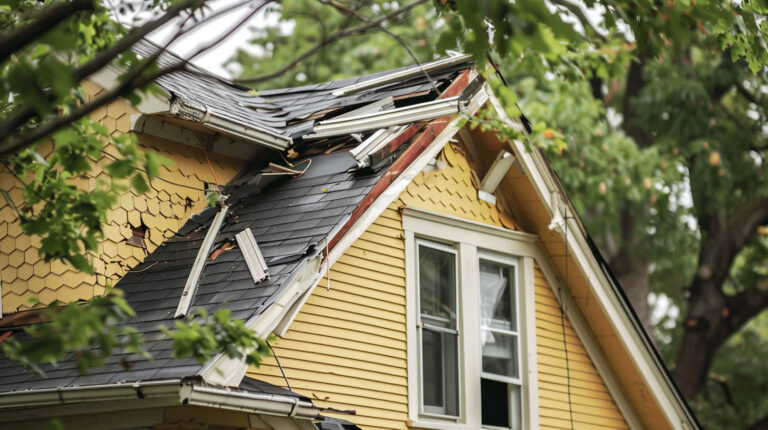
Blog
Hurricane Dangers: How to Protect Your Roof
Hurricanes are a constant threat to homes in Florida, and your roof is often the first line of defense. Ensuring that your roof is prepared for extreme weather is critical to protecting your property and minimizing damage. At Avenue Roofing, we emphasize the importance of preventive measures to safeguard your roof during hurricane season.

How Hurricanes Impact Your Roof
1. Wind Damage
Hurricane winds are powerful and can wreak havoc on even the most well-constructed roofs. For a storm to be classified as a hurricane, wind speeds must exceed 74 miles per hour. In extreme cases, a category 5 hurricane can produce winds greater than 156 mph. These winds can rip shingles from the roof, loosen flashing, and even cause complete roof failure in the most severe storms.
The force of the wind can also cause indirect damage. Falling branches or uprooted trees are a common hazard during hurricanes, potentially causing structural damage to your roof. Did you know that during Hurricane Irma, insured losses in Florida reached $17.44 billion? This demonstrates just how devastating wind damage can be to homes in the region.
2. Water Damage
Hurricanes bring not only wind but also torrential rain. When shingles are torn off by high winds, the interior of your roof is exposed, allowing water to penetrate and damage the underlying structure. Leaks can develop, leading to rot, mold, and in extreme cases, structural collapse.
Additionally, if your gutters are not functioning properly or become clogged, water can pool on the roof, increasing the weight and putting additional strain on the structure. Ensuring proper drainage is essential to prevent this type of damage.
3. Debris and Impact
Hurricanes frequently send debris flying through the air, including tree branches, outdoor furniture, and other loose objects. This debris can damage or puncture your roof, causing immediate leaks or even larger structural issues. It is critical to secure any loose items around your property before a storm hits to minimize the risk of debris-related damage.
How to Protect Your Roof Before a Hurricane
Regular Inspections
The best way to ensure your roof is ready for hurricane season is by scheduling regular inspections. A professional inspection can identify potential weak points in your roof, such as loose shingles, weakened flashing, or compromised gutter systems. Fixing these issues ahead of time can significantly reduce the risk of major damage during a hurricane.
Reinforce Vulnerable Areas
Certain areas of your roof are more susceptible to damage during a hurricane, particularly the edges and corners where wind uplift is strongest. Reinforcing these areas with stronger materials and securing loose components can help prevent wind-related damage. Installing hurricane straps or clips can also provide additional protection by anchoring the roof to the walls of your home.
Use High-Quality Materials
When it comes time to replace your roof, opt for high-quality materials that can withstand the extreme conditions of a hurricane. Asphalt shingles are popular, but if you’re in a hurricane-prone area, consider stronger materials such as metal or concrete tiles. These options may cost more upfront but can save you from expensive repairs or replacements down the line.
Unique Fact: Studies show that metal roofing can withstand winds of up to 140 mph, making it a preferred choice for homes in hurricane zones.
What to Do After a Hurricane
Inspect Your Roof
Once a hurricane has passed, it’s important to inspect your roof for damage. Look for missing shingles, dents, or any signs of water intrusion. If you notice any damage, contact a professional roofing contractor immediately. The sooner repairs are made, the less likely you are to experience further issues.
Document Damage
If your roof has sustained damage, document it with photos and detailed notes. This will be important when filing an insurance claim. Be sure to take pictures from multiple angles to fully capture the extent of the damage.
FAQs
1. Can my roof withstand a category 5 hurricane?
While some roofs can withstand category 5 hurricanes, it depends on the materials used and how well the roof is maintained. Metal roofs, for example, offer excellent protection against high winds.
2. How often should I inspect my roof for hurricane readiness?
It’s recommended to inspect your roof at least once a year, ideally before hurricane season. Any repairs should be completed as soon as possible.
3. What should I do if my roof is damaged during a hurricane?
If you suspect roof damage, contact a professional roofing contractor immediately for an inspection and repairs. Document the damage for insurance purposes.
4. Can I prevent hurricane damage entirely?
While no roof is completely hurricane-proof, taking preventive measures can significantly reduce the risk of damage.
5. Should I replace my roof before hurricane season?
If your roof is showing signs of wear or nearing the end of its lifespan, it’s a good idea to replace it before hurricane season begins.
Conclusion
Hurricanes pose a significant threat to homes in Florida, particularly to roofs, which are often the first defense against wind and water damage. By taking preventive steps like regular inspections, reinforcing vulnerable areas, and using high-quality materials, you can better protect your home during hurricane season. At Avenue Roofing, we specialize in helping homeowners safeguard their roofs against Florida’s toughest storms.
To find out how long it takes to replace a roof, click here.



